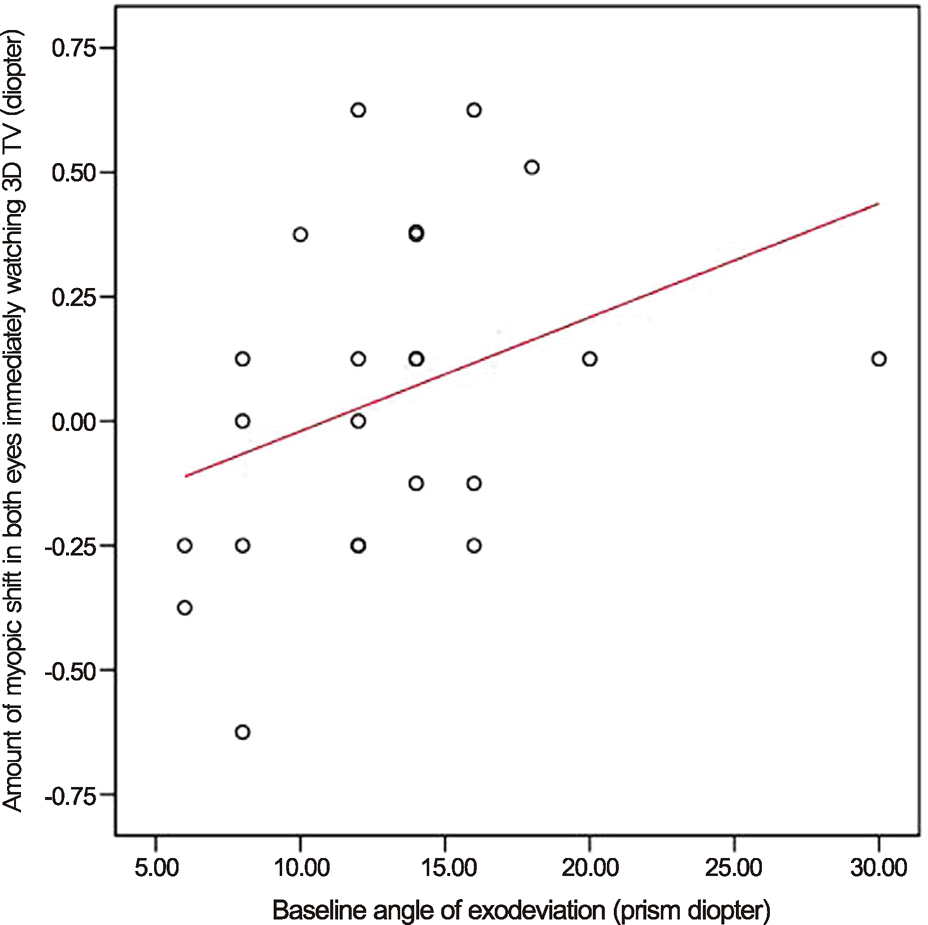Abstract
Purpose
To investigate the effects of watching three-dimensional (3D) television (TV) on the angle of deviation and refractive error in children with exodeviation.
Methods
Twenty-three volunteers with exodeviation, aged 6 to 12 years, without any ocular abnormalities other than refractive error and exodeviation were recruited for this study. The subjects watched 3D TV for 50 minutes at a viewing distance of 2.8 meters. The image disparity of 3D contents was −1 to 1 degree. Refractive errors were measured before and immediately after watching TV and after a 10-minute rest. The changes in angle of deviation were also obtained. Refractive errors and angle of deviation before and after watching 3D TV were compared.
Results
The mean age of the subjects was 9.30 ± 1.58 years. The mean baseline angle of deviation was 13.04 ± 5.25 (6-30) prism diopters (PD), which did not change significantly immediately after watching 3D TV and after a 10-minute rest (p = 0.452). The mean refractive errors were −2.15 ± 1.55 D in the right eye and −2.06 ± 1.55 D in the left eye before and changed to −2.14 ± 1.57 D and −2.11 ± 1.45 D, respectively, immediately after watching 3D TV. After a 10 minute rest, the mean refractive errors were 2.14 ± 1.53 D in the right eye and −2.07 ± 1.53 D in the left eye. All changes in refractive errors were not statistically significant (p = 0.991 in right eye, 0.495 in left eye). The amount of myopic shift in both eyes immediately after watching 3D TV was correlated with the angle of exodeviation (r = 0.468, p = 0.024). However, the correlation disappeared after a 10-minute rest (r = 0.345, p = 0.107).
Go to : 
References
1. Schowengerdt BT, Seibel EJ. True three-dimensional displays that allow viewers to dynamically shift accommodation, bringing objects displayed at different viewing distances into and out of focus. Cyberpsychol Behav. 2004; 7:610–20.

2. Lambooij M, Fortuin M, Heynderickx I, IJsselsteijn W. Visual discomfort and visual fatigue of stereoscopic displays: a review. J Imaging Sci Technol. 2009; 53:30201–1.

3. Hoffman DM, Girshick AR, Akeley K, Banks MS. Vergence-accommodation conflicts hinder visual performance and cause visual fatigue. J Vis. 2008; 8:33.1–30.

4. Howarth PA. Potential hazards of viewing 3-D stereoscopic television, cinema and computer games: a review. Ophthalmic Physiol Opt. 2011; 31:111–22.

5. Kim SH, Suh YW, Song JS, et al. Clinical research on the ophthalmic factors affecting 3D asthenopia. J Pediatr Ophthalmol Strabismus. 2012; 49:248–53.

6. Kim SH, Suh YW, Yun CM, et al. 3D asthenopia in horizontal deviation. Curr Eye Res. 2013; 38:614–9.

7. Kim SH, Suh YW, Yun C, et al. Influence of stereopsis and abnormal binocular vision on ocular and systemic discomfort while watching 3D television. Eye (Lond). 2013; 27:1243–8.

8. Iwasaki T, Tawara A. [The accommodative characteristics of gazing at stereoscopic images on a 3-D display]. Nihon Ganka Gakkai Zasshi. 2004; 108:5–11.
9. Ciuffreda KJ, Vasudevan B. Nearwork-induced transient myopia (NITM) and permanent myopia–is there a link? Ophthalmic Physiol Opt. 2008; 28:103–14.
10. Arunthavaraja M, Vasudevan B, Ciuffreda KJ. Nearwork-induced transient myopia (NITM) following marked and sustained, but interrupted, accommodation at near. Ophthalmic Physiol Opt. 2010; 30:766–75.

11. Suh YW, Oh J, Kim HM, et al. Three-dimensional display-induced transient myopia and the difference in myopic shift between crossed and uncrossed disparities. Invest Ophthalmol Vis Sci. 2012; 53:5029–32.

12. Horwood AM, Riddell PM. Evidence that convergence rather than accommodation controls intermittent distance exotropia. Acta Ophthalmol. 2012; 90:e109–17.

13. Ekdawi NS, Nusz KJ, Diehl NN, Mohney BG. The development of myopia among children with intermittent exotropia. Am J Ophthalmol. 2010; 149:503–7.

14. Seo HJ, Kim SH, Suh YW, et al. Influence of watching 3D television on refractive error in children. Proceedings of 3DSA. 2013; 2:2.
Go to : 
 | Figure 1.Correlation between the amount of myopic shift in both eyes immediately after watching 3D TV and the baseline angle of exodeviation. |
Table 1.
Change in the refractive error (diopter) and the angle of exodeviation (prism diopter) after watching 3D TV
Table 2.
Correlation coefficient between the amount of myopic shift immediately after watching 3D TV and the baseline angle of exodeviation
| Changes immediately after watching 3D TV | Correlation coefficient between each variables and the baseline angle of exodeviation (r*) | p-value |
|---|---|---|
| Change in angle of exodeviation | −0.355 | 0.097 |
| Amount of myopic shift (right eye) | 0.304 | 0.158 |
| Amount of myopic shift (left eye) | 0.309 | 0.152 |
| Amount of myopic shift (both eyes) | 0.468 | 0.024† |
Table 3.
Correlation coefficient between the amount of myopic shift after a 10-minute rest and the baseline angle of exodeviation
| Changes after a 10-minute rest | Correlation coefficient between each variables and the baseline angle of exodeviation (r*) | p-value |
|---|---|---|
| Change in angle of exodeviation | 0.027 | 0.903 |
| Amount of myopic shift (right eye) | 0.264 | 0.224 |
| Amount of myopic shift (left eye) | 0.355 | 0.096 |
| Amount of myopic shift (both eyes) | 0.345 | 0.107 |




 PDF
PDF ePub
ePub Citation
Citation Print
Print


 XML Download
XML Download